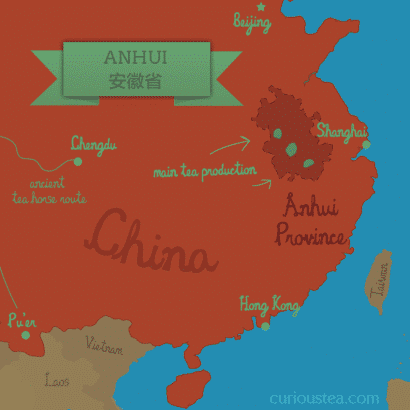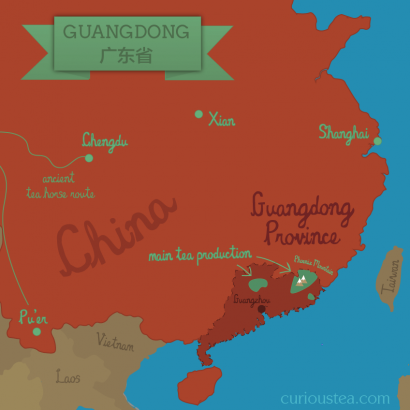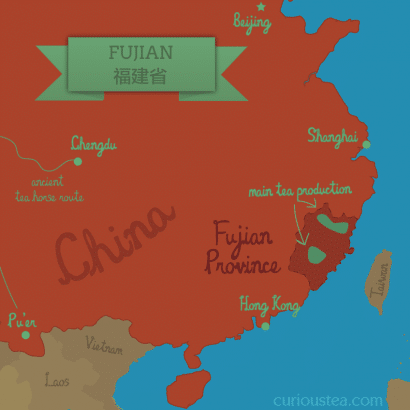Welcome to the June 2023 edition of the Curious Tea subscription! Here’s a closer look at the four exciting new teas that we are sharing with our subscribers this month. All our teas this month are from China and are from the fresh 2023 harvest.
The first light tea this month is a fine Xue Ya Snow Bud white tea from Guangxi Province of China that delivers a complex, refreshing flavour. The second light tea is a classic green tea from Tunxi District located near the famous Huangshan tea producing area of Anhui Province.
For the dark side of the selection we have a classic Dan Cong Oolong from Guangdong Province – the Mi Lan Xiang variety is known for a floral honey character. Finally the last tea to be featured is a loral aroma Xiao Zhong from Fujian Province, made from old tea trees grown semi-wild in Wuyi Shan.
Our Discovery subscription boxes contain 10g taster pouches of all of the above mentioned teas. If you are a subscriber you will benefit from a 10% discount on all teas from our tea shop!
Let’s get into further detail on these teas featured in our June tea subscription boxes.
Xue Ya Guangxi Snow Bud
Xue Ya Guangxi Snow Bud (广西雪芽) is a complex and flavoursome white tea. It is grown in Baise, Guangxi Province, utilising plants specifically used for white tea production that originate in the famous Fuding tea growing area of Fujian Province. The small silver leaves produce a herbaceous liquor with a buttery and savoury flavour. This particular tea is grown to organic standards and is an early spring First Flush pre-Qing Ming harvest from 10 March 2023.
The Xue Ya name, which literally means Snow Bud, comes from the appearance of the silver buds when plucked – they look as if covered by snow. There is plenty of this silvery, downy ‘fur’ on the dried leaves of this tea, signifying it is made from fine tips. When the leaves are brewed and unfurled, it is possible to see that they are mostly represented by smaller buds. The use of such small, young leaves that are still covered in silvery ‘fur’ results in a very fine yet complex taste.
Guangxi Province is not particularly famous for growing white tea, but some farmers have brought plants from Fujian and planted them for white tea production here. Similar to our Yin Zhen Guangxi Silver Needle, the cultivar utilised is the famous Fuding Da Bai (福鼎大白 – Fuding Large White). This cultivar is used in Fujian to produce our Xue Ya Snow Bud. However with the change of terrior comes a change in flavour. While white teas tend to be more delicate, having a very light profile, the Xue Ya style generally has a more complex and robust flavour. This Guangxi Xue Ya also delivers a more robust version of a white tea, however we think it is a little better balanced with more interesting and unusual flavours when compared to the Fuding version.
Xue Ya Guangxi Snow Bud is made up of small very neat buds. When brewed, it produces a clear and bright liquor with a pale jade colour and a herbaceous aroma that has verdant hints of parsley and smoked butter. The herbaceous profile has a complex and refreshing taste. The initial flavour starts with savoury notes of toasted nori seaweed, salted plums and a hint of peachy fruitiness. These flavours then give way to clean verdant notes of buttered parsley. The buttery aspect is reflected particularly well on the mouthfeel. The finish is clean, with a lasting warming and comforting sensation.
This tea is best brewed at 80°C for 3-4 minutes according to your taste, brewing multiple times. Like with all white teas, you can experiment with both low temperature and long steeping time as well as high temperature and short steeping time as an alternative way of brewing.
You can also buy this Xue Ya Guangxi Snow Bud white tea in our online shop.
Tun Xi Lu Cha
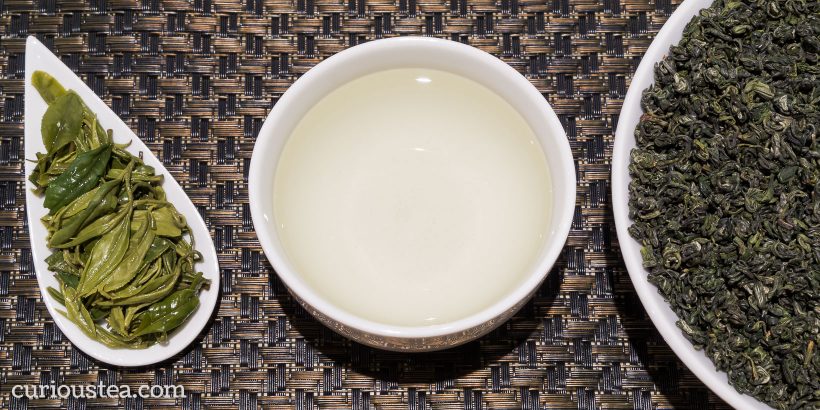
Tun Xi Lu Cha (屯溪绿茶) is a premium green tea from the south-eastern part of Anhui Province in China. Grown around Tunxi District of Huangshan City, the location borders the famous Huangshan ‘Yellow Mountain’ (黄山市) mountain range. It is a highly regarded green tea that is mentioned in many lists of the Famous Teas of China. Carefully processed from young tender spring leaves picked 18 April 2023.
The name of this Tun Xi Lu Cha comes from the origin place name of this tea (Tunxi District – 屯溪区) and the descriptive addition of the fact that it is a green tea (Lu Cha – 绿茶). We prefer the full Tun Xi Lu Cha name but with passing of time this full name has been condensed into ‘Tunlu’ or ‘Tunlv’ (Tunlü), a name that is often used to refer to this specific green tea. Interestingly, the english term twankey or twankaythat was used to refer to green tea, often of inferior quality, originated from the Tunxi name. And yes, Widow Twankey of the Aladdin pantomime fame does get her name from the reference to a cheap green tea that is past its best! ‘Twankey’ most likely comes from the cantonese pronunciation of this place – ‘Tuen Kai’. Of course, like many historic tea terms, the twankey terminology is somewhat outdated now, so we shall stick to the correct Chinese Tun Xi Lu Cha as the proper name for this tea.
Tun Xi Lu Cha green tea has some similarities to the famous Huang Shan Mao Feng green tea in terms of flavour profile. However these are rather different in appearance with the leaves of Tun Xi Lu Cha, being a little more fully developed. While still consisting of tips and small leaves, the slightly later harvest of the more developed leaves leads to a more pronounced flavour. This tea sits somewhere in between our Huang Shan Mao Feng and Huang Shan Yun Wu in flavour intensity with Mao Feng being most delicate and Yun Wu being the strongest. This does mean that this Tun Xi Lu Cha has a very balanced flavour and an approachable character.
Unlike many other Chinese green teas, Tun Xi Lu Cha green tea comes in leaves that are very slightly rolled. Not quite as much as a rolled oolong but closer to some Bi Luo Chun teas in appearance. When brewed, the dry leaves unfurl and you can see attractive small leaves and buds in your brewing vessel. These produce a light green-yellow liquor with a vegetal and floral aroma. The very smooth taste is brisk and a touch drying. The notes are predominantly vegetal (think courgettes and asparagus), with herbaceous, green floral and lightly metallic notes. The aftertaste is tangy and refreshing. There is a touch of tannic dryness at the end of the taste, however this does not translate into any real bitterness, astringency or harshness. Overall this is a very balanced, smooth and approachable green tea that is not overcomplicated by various distinctive and domineering flavours.
This green tea is best brewed at 80°C for 2-3 minutes according to your taste and can be brewed more than 3 times, increasing steeping time with each next brew if desired.
You can also buy this Tun Xi Lu Cha green tea in our online shop.
Dan Cong Mi Lan Xiang
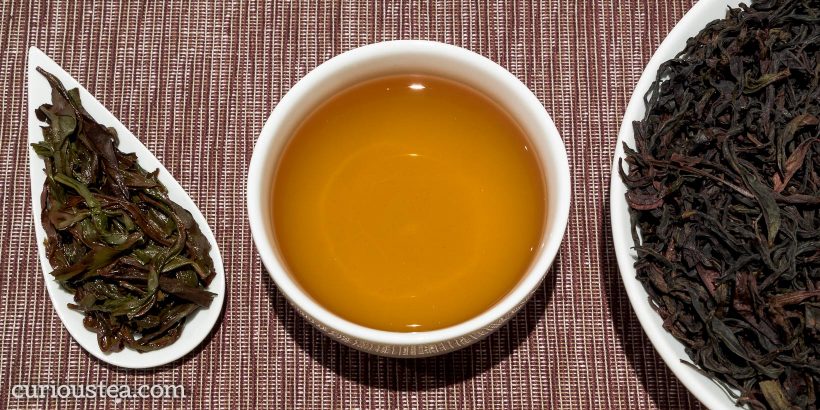
Dan Cong Mi Lan Xiang Oolong (单枞蜜兰香), known as Honey Orchid Fragrance Phoenix Oolong, is an excellent example of a Dan Cong Oolong – a famous style of tea from Guangdong Province in Southern China. This is a traditional Mi Lan Xiang oolong that has a pronounced floral and honey aroma and taste, complete with a complex aftertaste that is mineral and lightly roasted. It is grown in the Phoenix Mountain area near Chaozhou City (Phoenix Town) in Guangdong Province at an altitude of about 1,000-1,500 metres on the rocks of Wudong Mountain. Picked from semi-wild trees of the Shui Xian cultivar that are about 30 years old, the current batch is from 3 March 2023 harvest.
Dan Cong Oolongs are noted for their ability to imitate various flavours, be it flowers or fruits. This is a natural characteristic developed through selecting specific tea trees and applying specific processing techniques. The aroma and taste differences of Dan Cong Oolongs are mostly introduced during the finishing process of each tea. The skills of the tea master are therefore paramount in how each batch of tea turns out. This Mi Lan Xiang Dan Cong Oolong for example is noted for its ‘Honey Orchid’ aroma and flavour.
Dan Cong (单枞) is the general name that is used to refer to oolongs that come from Guangdong and specifically from Phoenix Mountain. Dan Cong literally means ‘single bush’ as traditionally these oolongs were all picked only from single trees. Each batch would be picked from only one tree and sold as such, without mixing of leaves from different trees, in order to preserve the unique flavour and experience of each specific tree. Of course while it is possible to still find teas that really are ‘single bush’, the reality is that they are extremely rare and expensive. However tea masters are still able to achieve a specific taste even with mixing of the leaves from different trees through skilful traditional tea processing techniques.
Many types of Dan Cong teas have been developed, all with unique characteristics and flavours. Mi Lan Xiang is probably amongst the most famous and recognised types. Now with the changing of processing techniques the term Dan Cong has become more of a generic term to cover all Phoenix Mountain (Fenghuang Shan 凤凰山) and sometimes other Guangdong Oolongs. Phoenix oolongs are very varied in style and flavour but are often sold just as ‘Phoenix Mountain Oolong’ or ‘Phoenix Dan Cong’ often not specifying the exact type of Dan Cong or where it is from. Make sure to look out for which particular Dan Cong you are buying as they all have varying characteristics and styles depending on where and how they are grown and processed.
The semi-wild tea trees that are used to produce this tea are Fenghuang Shuixian ‘Water Lily’ (凤凰水仙) cultivar bushes. Shui Xian is also known as ‘narcissus’ or ‘water sprite’. The Shui Xian cultivar is present both around Fenghuang Shan (凤凰山) in Guangdong Province and in Wuyi Shan (武夷山) in Fujian Province and in both locations it is responsible for producing some of the best and most enigmatic oolong teas in the world. There is some debate as to whether Shui Xian originated in Guangdong or in Fujian, however the terroir greatly affects the final outcome with each region producing quite distinctive teas. The semi-wild nature of the trees means that they are left to grown naturally on rocky mountainsides. The age of the trees, the natural biodiverse growing conditions and rocky terrain attribute to slower leaf growth and higher concentration of flavour. The trees are able to absorb more nutrients concentrating these in the leaves and resulting in a powerful and flavoursome tea.
The dark and twisted dry leaves of this Dan Cong Mi Lan Xiang Oolong produce a medium golden liquor. The aroma is quite floral, with a lightly baked edge. The taste of this tea is quite exceptional and shows off the true nature of a Dan Cong oolong. The main profile is that of wild honey, with notes of exotic flowers and fruits. The aftertaste is complex and lasting, with a lightly roasted touch. There is a mineral edge to the aftertaste that can be attributed to the semi-wild nature of the trees as well as their age. This tea is good to drink straight away but would also benefit from resting for up to 1-2 years to mellow and develop the flavours.
This Dan Cong Mi Lan Xiang Oolong can stand many infusions. Infuse it the western way in a tea pot at 90°C for 3 minutes 3+ times. If you are finding that your tea is turning out a little too astringent, you can reduce the brewing time or temperature until you reach your preferred taste. This tea would particularly benefit from traditional gongfu style brewing, yielding a lot more infusions, each bursting with flavour. It is a fascinating way of seeing how the tea changes with each infusion.
You can also buy this Dan Cong Mi Lan Xiang oolong tea in our online shop.
Hua Xiang Lao Cong Xiao Zhong
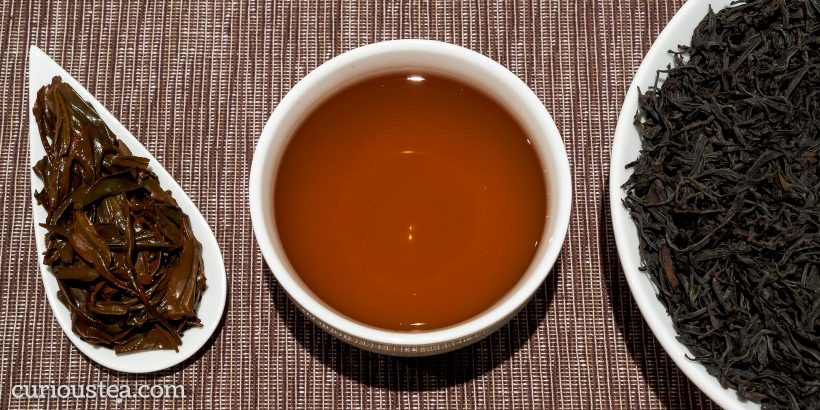
Hua Xiang Lao Cong Xiao Zhong (花香老枞小種) ‘Flower Fragrance Old Tree Small Leaf’ is an intriguing and unusual black tea from the mountainous terrain of Wuyi Shan (武夷山). Grown around Tongmu Village, famous for producing the best Jin Jun Mei and Lapsang Souchong, it is picked from semi-wild 30+ year old trees that grow on rocky mountain slopes. This tea produces a complex liquor with flavours that are savoury, spicy and mineral, yet showing a lasting sweet aftertaste. 15 April 2023 harvest.
While Lapsang Souchong is the famous smoked tea hailing from Tongmu Village, the area also produces some fantastic unsmoked black teas. Zheng Shan Xiao Zhong is a prime example of this local speciality, however we would class that as an entry level tea. By comparison, this Hua Xiang Lao Cong Xiao Zhong stands out on two counts. First, it is known as Huaxiang (花香), meaning flower aroma in Chinese. This is attributed to a particularly flowery edge. It is quite different to bright floral highlights you might find in lightly oxidised oolong teas, displaying a more complex, deeper and subtle flower aroma. And second, it is also classed as a Laocong (老枞) tea as it comes from old bushes that are at least 30 years old. While it cannot compete with 100+ year old bushes found in other areas, the old tree nature certainly leads to a distinctive mouthfeel and aftertaste.
The Xiaozhong (小種) part of the name literally means ‘Small Leaf’, referring to the small leaf tea plant that is used to produce this tea. This type of plant is found around Wuyi Shan and is used to make various black teas from this area. The Xiaozhong tea plant is also known as Caicha (菜茶), a generic term that is used to describe tea plants that are native or indigenous to certain parts of China. While these types of plants have differentiating features in different regions, they are still not uniform due to normal natural variation in the plants. So Caicha or Xiaozhong is not a specific cultivar but rather a type of a tea plant that can be found around Wuyi Shan that has small leaves and appeared naturally and over long time as a result of natural hybridisation. In this way, it is similar to zairai plants in Japan or tea plants found in most of South Korea.
This Hua Xiang Lao Cong Xiao Zhong has dark, twisted, aromatic dry leaves. The dark amber liquor has good clarity and a savoury, spicy aroma. The savouriness comes through on the taste profile, with more notes of spices, roasted red peppers, tomato soup. There is a pleasant mineral aspect running through the taste reminiscent of the rock taste found in the best Wuyi Shan oolong teas. The aftertaste is sweet, smooth and lasting. Overall this tea leaves a very smooth impression of complex savoury flavours that can attributed the leaves originating from semi-wild old trees.
It is best brewed at 90°C for 3-4 minutes, with multiple infusions. For best results, brew gong fu style.
You can also buy this Hua Xiang Lao Cong Xiao Zhong black tea in our online shop.
We really do hope that you enjoy this tea selection and are looking forward to the selection in our July box. It will feature a Yu Shan Taiwanese Oolong that was custom baked for us during our recent visit to our tea master in Taiwan and a Jasmine scented oolong from Thailand. For the dark side of the selection, we have our popular Ceylon Silver Tips black tea and a complex second flush muscatel Darjeeling from Gopaldhara.
If reading this has made you curious about our teas, but you don’t yet subscribe to a monthly tea selection, you can sign up for our tea boxes in just a few clicks. We ship worldwide from London, UK.
We always love to hear from you, so if you have any questions, suggestions or just want to chat about tea, email us at contact@curioustea.com, via our Facebook page or via Twitter.


